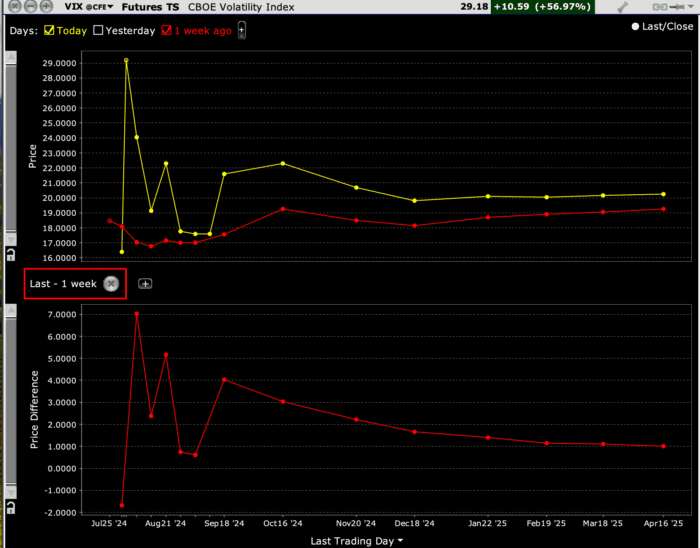Where to begin? The 2-day bout of volatility, the good and the bad kind? The continuing “routation”? Apple (AAPL) eking out a gain, though muted because so much good news had been priced in? Amazon (AMZN) getting whacked because they also had so much good news priced in yet came short on guidance? The Nikkei getting thrashed, down over -5% last night and having a greater than 10% correction in about 3 weeks? Or the shockingly weak jobs numbers?
Let’s unpack the themes:
Regarding the 2-day swing: If we were in a bear market – which to be clear, we are not – I would have called Wednesday’s move a bear market rally. It had that sort of panicky, over-aggressive buying that characterizes the short, sharp, and furious upward moves that punctuate bear markets.
- I believe that the buying was highly abetted by month-end factors – institutional accounts may have felt that they reduced their exposures too much and wanted to get back onsides before they had to report.
- Much of the recent selling was related to the unwinding of the carry trade. Until Wednesday, the yen and Nasdaq 100 (NDX) were moving in rough lockstep. As the yen strengthened, the NQ futures fell. Hedge funds borrowing in yen to buy big tech were clearly unwinding, though the Bank of Japan meeting and helpful comments from Microsoft (MSFT) — ok, they were helpful for Nvidia (NVDA) and AMD, if not MSFT itself — broke the relationship. It seems to have resumed on Thursday – see the chart below.
- The plunging Nikkei 225 (NKY) is clearly another side effect of the imploding carry trade. It was easy to borrow a weakening yen to buy stocks that were rising because the yen was sinking. That unraveled in a hurry, and in a very messy way last night.
- Forced selling becomes indiscriminate selling!
20-Days, JPY (white), Front-Month NQ Futures (magenta)

Source: Bloomberg
In contrast, yesterday’s problems were a case of careful what you wish for.
- On Wednesday, Chair Powell confirmed that a September cut is highly likely (even if the FOMC statement didn’t) and traders priced in cuts at each of the next three remaining 2024 meetings. Mind you, that was not the cause of Wednesday’s rally. The S&P 500 (SPX) closed about where it was before the presser.
- Then yesterday’s weekly claims and the ISM report, normally not market movers, hit home hard. Since the market was already pricing in 3 cuts, we have put ourselves in a situation where bad news is bad. If we’re already expecting cuts when the soft-landing narrative was in place, can we expect more if the economy turns south? Or is it more a case of the Fed potentially being late to the party?
- The recent rally in bonds – 2-yr yields are down 85 basis points since the end of June (!) and 10-yr yields down over 58 bp in that timeframe – is another “tell” that fixed income investors are pricing in economic weakness, with a flight to safety thrown in for good measure
- One of the things I’ve noticed over the years is that when stocks and bonds tell different messages about the economy, it’s the bonds that are more likely to be correct.
Having spent most of my career as an options market maker, this is where I view things through a volatility-oriented lens. Even though the two moves were of similar magnitude, VIX rallied much more yesterday than it fell on Wednesday. And the overnight moves created even more angst, with VIX over 20.5 as I type this!
- I have always believed that VIX is not a fear gauge, it just plays one on TV
- That said, it is the best proxy for institutions’ demand for hedging insurance. And that demand increases when portfolio managers get fearful.
- They’ve been getting increasingly more concerned about something.
- A seasonal swoon?
- A belated concern that the last leg of the rally was a “blowoff top”?
- The new propensity for stocks to get clobbered even after good earnings reports?
- “Socially Acceptable Volatility”: Even though volatility measures are agnostic – volatility measures up AND down moves equally – investors don’t. I termed Wednesday’s move socially acceptable because we went up. Markets are supposed to go up. So even though volatility increased, VIX traded down. Yesterday was plain old, scary volatility, even though the moves were of similar magnitude, so VIX shot higher.
“Routation” – This is the term that I have been using to describe how there is still solid rotation from growth to value underneath the market’s surface. The problem is that the megacap tech stocks grew to such a heavy weight in cap-weighted indices like SPX and NDX that any sustained selling in those names would drag the markets lower no matter what.
- 8 names (Mag 7 + AVGO) comprise about 1/3 of SPX and ½ of NDX. That means that many who have been buying SPY or index funds have not been nearly as diversified as they might have thought
- I warned against this, terming the most recent leg of the rally “Stock Market Jenga” as the indices rose higher on an ever-shrinking foundation.
- The Routation made that apparent when we started to turn lower a couple of weeks ago.
Earnings are a problem. Or more specifically, investors’ reaction to them is a problem. Sure, we’re getting our usual high percentage of EPS beats, but that’s no longer sufficient. Stocks that are priced to perfection require perfection, so the slightest slip-up in revenues, EPS, or guidance is enough to trip up stocks that have sustained huge rallies – especially in big tech and semiconductors
- Think about GOOGL, which beat and fell because of comments about AI spending. And then MSFT, which did the same.
- Now consider semis like AMD and QCOM, which initially rallied after solid reports, then got throttled after investors digested them
- Not to mention INTC, which is an outright disaster, an ongoing trainwreck
- When we’re priced for perfection, anything short of perfection gets punished
Finally, a few quick comments about this morning’s payrolls report:
- I’m not certain that this is a hard landing, but it certainly is a bumpy one
- Nonfarm Payrolls rose far less than expected (+114,000 vs. 175k consensus)
- The jump in the Unemployment Rate to 4.3% (4.1% expected) triggered the Sahm Rule, a noted recession indicator, though Dr. Sahm herself is calling it into question
- Is today the day that another recession indicator, the 2-10 inversion, disappears? We momentarily touched 5bp, it’s now about 10bp. While that potential recession indicator has been gestating for quite a while, remember that the recession only begins when the curve disinverts. (Not rooting for this, but we have to be aware of it)
2-year Treasury Yields Minus 10-year Treasury Yields with NBER Recession Starts (red) and Ends (green), Since 1985

Source: Bloomberg, Interactive Brokers
Bottom line: It feels like a sea change in sentiment is occurring. I can’t be certain that this is anything more than seasonal angst right now, but the 29 VIX is flashing a huge red flag. The demand for volatility protection exploded relative to the available supply, as evidenced by the steeply inverted VIX futures curve. (The October bump, which was quite noticeable, now seems quite minor). There are a lot of people saying “get me out”, or worse, many of them being forced out. That can make for profitable trades, but only for the truly bold and risk tolerant.
VIX Futures Term Structure, Today (yellow), Last Week (red, top), With Changes Below

Source: Interactive Brokers
Join The Conversation
For specific platform feedback and suggestions, please submit it directly to our team using these instructions.
If you have an account-specific question or concern, please reach out to Client Services.
We encourage you to look through our FAQs before posting. Your question may already be covered!
Leave a Reply
Disclosure: Interactive Brokers
The analysis in this material is provided for information only and is not and should not be construed as an offer to sell or the solicitation of an offer to buy any security. To the extent that this material discusses general market activity, industry or sector trends or other broad-based economic or political conditions, it should not be construed as research or investment advice. To the extent that it includes references to specific securities, commodities, currencies, or other instruments, those references do not constitute a recommendation by IBKR to buy, sell or hold such investments. This material does not and is not intended to take into account the particular financial conditions, investment objectives or requirements of individual customers. Before acting on this material, you should consider whether it is suitable for your particular circumstances and, as necessary, seek professional advice.
The views and opinions expressed herein are those of the author and do not necessarily reflect the views of Interactive Brokers, its affiliates, or its employees.




















Count me as a victim of the vol. Thursday morning I went long 1 contract of RTY at what, absent of the changed narrative/sentiment that I didn’t learn of in adequate time, should have been close to an intraday bottom at 2206. Oh my, was I in for a ride. My stop loss triggered of course, and quite frankly I’m lucky the speed of the downward momentum didn’t blow through it without filling. RTY, of the four index futures “should” have been the most resilient, as of the open yesterday, still basking in the glory of near 100% mkt certainty of incoming rate cut(s). But alas, it was what it was. I would say “lesson learned” but to be honest I’m not sure I could see a similar Rapidly Deployed Sentiment Change (RDSC … an abbrev I just now coined…) incoming again next time. Peace to all, and be cautious, prudent, and patient out there in vol land. (I wonder what this weekend holds for potential geopolitical developments).
Steve, I think you nailed it in your analysis. This market feels like there will be a lot of volatility going forward facilitated by investors continuing over anticipation of FED moves coupled with the underlying economics of a potentially slowing of the economy yet without a true pullback of consumer prices. People use the term “inflation is coming down” and forget that higher consumer prices are here to stay for a while yet the rate at which they are increasing may be slowing. I don’t believe there is a true understanding of the disposable income of the consumer in this environment. I think the 2yr vs 10yr yield spread is interesting to say the least.
I like this pairs trade a lot now: Whenever AMZN drops below GOOG, you buy AMZN and short GOOG, It has a very high rate of success. Of course, it is possible that they move in sync for a while, with neither one moving more than a few dollars above the other one, but time and time again it has always been Amazon that trades well above Google. Check the charts. This is a winner.
klac. down, then up to 825, then crash to 690. now what?